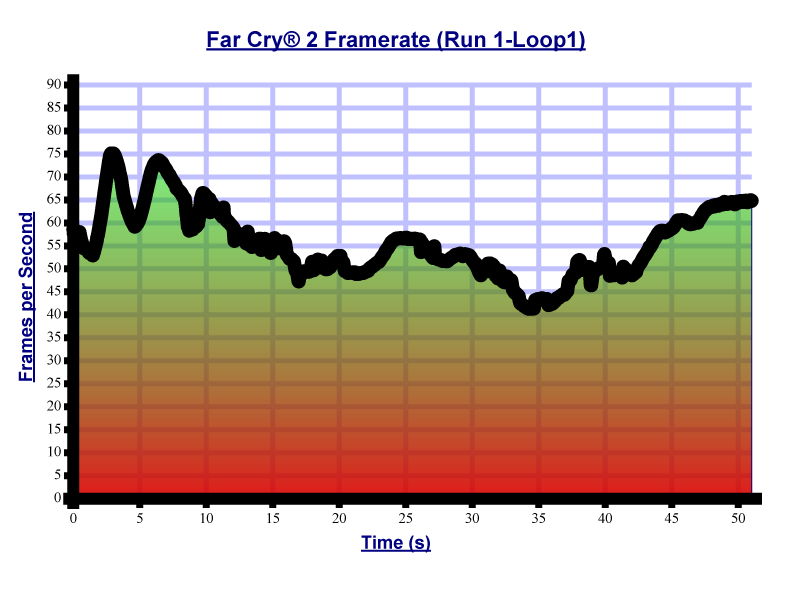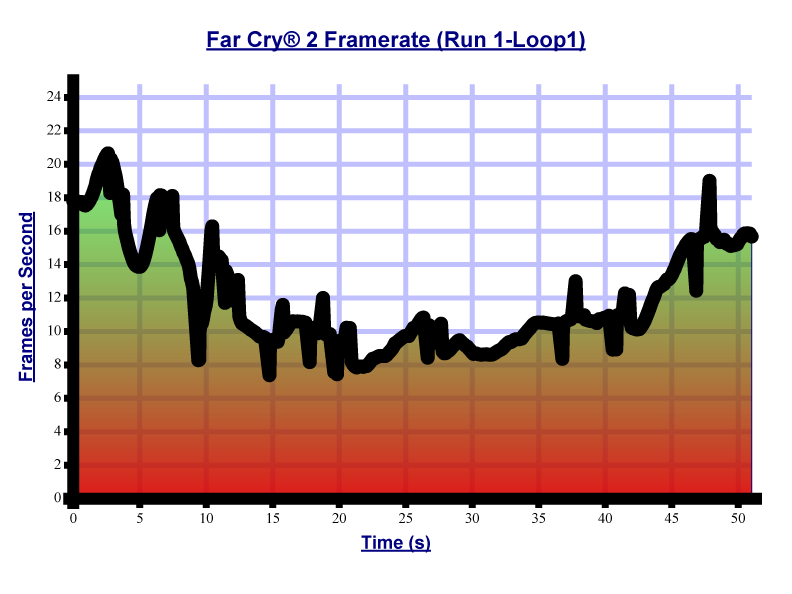Far Cry 2

Ubisoft has marketed Far Cry 2 as the true sequel to Far Cry, though the sequel has very few noticeable similarities to the original game. Instead, it features completely new characters and setting, as well as a new style of game play that allows the player greater freedom to explore different African landscapes such as deserts, jungles, and savannas. The game takes place in a fictional modern-day Central African nation in a state of anarchy and civil war. The player takes control of a mercenary on a lengthy journey to locate and assassinate “The Jackal,” a notorious arms dealer. The game play of Far Cry 2 more closely resembles that of Grand Theft Auto rather than that of the original Far Cry.
I had a few runs with Far Cry 2’s benchmark software and decided to use the two extremes (low setting test and high setting test).
Low setting run
Settings: Demo(Ranch Small), 1680×1050 (60Hz), D3D10, Fixed Time Step(No), Disable Artificial Intelligence(Yes), Full Screen, Anti-Aliasing(None), VSync(No), Overall Quality(Optimal), Vegetation(High), Shading(High), Terrain(High), Geometry(High), Post FX(High), Texture(High), Shadow(High), Ambient(High), Hdr(Yes), Bloom(Yes), Fire(Very High), Physics(Very High), RealTrees(Very High) |
| Loop 1 |
- Total Frames: 2836, Total Time: 51.01s
- Average Framerate: 55.60
- Max. Framerate: 75.12 (Frame:179, 2.87s)
- Min. Framerate: 41.30 (Frame:1919, 34.29s)
|
 |
And now the second run:
Run 1
Settings: Demo(Ranch Small), 1680×1050 (60Hz), D3D10, Fixed Time Step(No), Disable Artificial Intelligence(Yes), Full Screen, Anti-Aliasing(8x), VSync(No), Overall Quality(Ultra High), Vegetation(Very High), Shading(Ultra High), Terrain(Ultra High), Geometry(Ultra High), Post FX(High), Texture(Ultra High), Shadow(Ultra High), Ambient(High), Hdr(Yes), Bloom(Yes), Fire(Very High), Physics(Very High), RealTrees(Very High) |
| Loop 1 |
- Total Frames: 609, Total Time: 51.01s
- Average Framerate: 11.94
- Max. Framerate: 20.65 (Frame:49, 2.61s)
- Min. Framerate: 7.38 (Frame:211, 14.75s)
|

|
The Q9400 definitly faired well in this test. While not entirely playable at max settings, the Q9400 was still able to acieve an average of 11.94 FPS with a max of 20.65.
Related




Maybe you could make changes to the page title Intel Core 2 Quad Q9400 Processor | TechwareLabs to more better for your webpage you make. I liked the the writing yet.
The benchmarks against gpu orientated apps is essential as the cpu has the pcie controller on board and the i5-750 has a massive portion of the die just for that purpose.
here is a technology that asus has in the motherboard that does the same as demnd base switching and turbo boost.If you unleash them it will be cheaper and the same powerful
where is that technology?
hey, just wondering if anyone has a view on weather or not the new Core i7 920 system is worth the extra $400 or so?
thanks
You can check out our review of the i7-920 here:
http://www.techwarelabs.com/intel-core-i7-920/
I think its a great processor, but you have to take into account that you will need to upgrade Motherboard, RAM, and aftermarket CPU heatsink (if you want one). I think its worth the extra money if you are building one from scratch, but if you already have a quad core, its really not necessary. However, in the event that you are looking to get a completely new computer, i would go for the i7, as it allows you that little bit of room for upgrade in the future.
Hi, interesting post. I’ll write you later about few questions!
Thanks! What sort of questions do you have?
“As you can see the Q9400 faired very well considering it’s competition staying relatively close to the QX9650 in the multi-core efficiency test, and proving a worthwhile improvement over the ever popular 65nm 2.66Ghz Q6600 in the same test. The Q9400 definitely falls in line with the other processors of the same family.”
Either you meant to say 2.4Ghz (the default speed of the Q6600), or you meant to say QX6700 (default speed of 2.66Ghz)
Care to do some tests at the same clock speed AND bus speed to show real world clock for clock difference – if there is any?
The 333 vs 266 bus and RAM speed is going to make a bit of a difference… possibly enough to explain almost all of the performance difference between the Q6xxx and the Q9xxx series of processors.
I chose the Q6600 because of the popularity. If we had a Q6600 or Q6700 I would have done a comparison test from the get go. I can assure you that a mere increase in FSB speed, and core clock speed is not not all that was changed going to the the Yorkshire line, especially since the Q9400 has less cache than the Q6600 and Q6700.
Also the 2.66 was a typo; it should be 2.4GHz. We just went to a new site and I’m still unfamiliar with it. I’m in the process of figuring out how to change my typos.
Edit: typo have been fixed.
“The Multiprocessor Speedup reported during the second phase was a 3.62x which isn’t much considering 3 more cores are being used. Ideally, we’d like to see something close if not higher than 4x. This could be caused by a number of things though, such as the cache or the software.”
Oh dear. Better edit that, or get a reviewer with more indepth knowledge of CPU architecture, thread scaling, and cinbench. A 3.62x multiplier is probably the BEST I have seen on a quad. What are you talking about… expect over 4x? What nonsense.
@lemonadesoda
Hey thanks for catching that, you are right. I didn’t mean to say that. Closer to x4 would be ideal but definitely not more than x4. We have seen quad cores much closer to x4 before.
Seriously, benchmarking a CPU while the games are configured to stress the graphics card instead of the CPU?
In Far Cry 2 and Crysis warhead, you’r actually benchmarking the GPU more than the CPU. Its more likely the GPU being the bottleneck there, since i own a Q9400 and running those games at those settings with a 9800GTS 1GB @ 700/1750/1010 gives more performance specially with AA enabled.
I’m aware that the CPU could bottle-neck the GPU and that you are mostly benchmarking the GPU with these tests, but I did not have access to a motherboard with integrated graphics on it to better stress the CPU or a worse GPU. There is a chance that other factors are causing us to receive a low score such as the RAM.
As you point out, games mostly use the GPU which is why more than half the review focuses on CPU specific benchmarks. It seems to me that you skipped over what was actually important (like PC Mark) and went straight to the end.
While I Do agree with you, the bottleneck of games is in the GPU, there comes a point where we try to push reality into the picture. Most people that go and buy a Q9400 are just doing so to have a Quad Core. They’re usually not going to have 2 – GTX295’s in SLI. So what we did is put an upper-middle grade GPU with an upper middle grade processor to see how it would perform.
Sure, we could have thrown it in a computer with 3 – GTX 295’s and found the bottle neck, but that wasn’t the point of these tests. We wanted to give it a real world test that it was actually likely to encounter. Don’t get me wrong, it did great. Something that you have to realize is that if you have the same computer running the same test back to back, the tests will not always be the exact same. Furthermore, if you take a CPU and put it in one computer to test, it will get different results than if you put it into another computer with different hardware. Theoretically, the bottleneck of the processor is in the motherboard, RAM, GPU, and even the PSU.